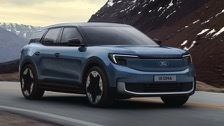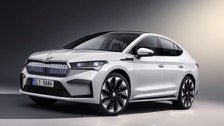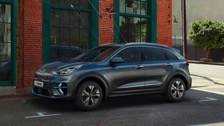Price from £37,295
| Availability |
Available to order |
| Available to order since |
July 2022 |
| Available to order until |
- |
Lease (BCH) from
£356 pcm
| Annual VED |
£0 |
| Congestion Charge |
£0 |
| Insurance Group |
28-29 |
Price shown is On The Road Price: it includes VAT, first year VED, vehicle first registration fee, number plates and delivery. Contract hire estimate by
e-car lease t/a CarLease (UK) Ltd who are a credit broker not a lender. Offer based on a business contract hire usership agreement, 6+35 profile, 10,000 miles per annum, excluding optional maintenance package and subject to VAT. Prices subject to terms and conditions.
Real Range between 170 - 360 mi
| City - Cold Weather |
235 mi |
| Highway - Cold Weather |
170 mi |
| Combined - Cold Weather |
200 mi |
| City - Mild Weather |
360 mi |
| Highway - Mild Weather |
220 mi |
| Combined - Mild Weather |
275 mi |
Indication of real-world range in several situations. Cold weather: 'worst-case' based on -10°C and use of heating. Mild weather: 'best-case' based on 23°C and no use of A/C. For 'Highway' figures a constant speed of 70 mph is assumed. The actual range will depend on speed, style of driving, weather and route conditions.
Battery
| Nominal Capacity * |
68.0 kWh |
| Battery Type |
Lithium-ion |
| Number of Cells |
96 |
| Architecture |
400 V |
| Warranty Period |
7 years |
| Warranty Mileage |
100,000 mi |
| Useable Capacity |
64.8 kWh |
| Cathode Material |
No Data |
| Pack Configuration |
96s1p |
| Nominal Voltage |
358 V |
| Form Factor |
No Data |
| Name / Reference |
No Data |
Charging
Home / Destination
| Charge Port |
Type 2 |
| Port Location |
Front Side - Middle |
| Charge Power † |
11 kW AC |
| Charge Time (0->240 mi) † |
7 hours |
| Charge Speed † |
35 mph |
Rapid Charging
| Fastcharge Port |
CCS |
| FC Port Location |
Front Side - Middle |
| Fastcharge Power (max) |
80 kW DC |
| Fastcharge Power (10-80%) |
70 kW DC |
| Fastcharge Time (24->192 mi) |
41 min |
| Fastcharge Speed |
240 mph |
| Autocharge Supported |
Yes |
Plug & Charge
| Plug & Charge Supported |
No |
† This can only be achieved using a 3-phase grid connection. The majority of homes and charge points do not have this connection. In practice charge power will often be 7.4 kW, allowing for a charge time of 10h30m and a charge speed of 23 mph.
Bidirectional Charging (V2X / BPT)
Vehicle-to-Load (V2L)
| V2L Supported |
Yes |
| Max. Output Power |
3.6 kW AC |
| Exterior Outlet(s) |
1 x Type 2 (Adapter) |
| Interior Outlet(s) |
1 x UK Socket (BS1363) |
Vehicle-to-Home (V2H)
| V2H via AC Supported |
No |
| Max. Output Power |
- |
| V2H via DC Supported |
No |
| Max. Output Power |
- |
Vehicle-to-Grid (V2G)
| V2G via AC Supported |
No |
| Max. Output Power |
- |
| V2G via DC Supported |
No |
| Max. Output Power |
- |
Energy Consumption
EVDB Real Range
| Range |
240 mi |
| Vehicle Consumption |
270 Wh/mi |
| CO2 Emissions |
0 g/km |
| Vehicle Fuel Equivalent |
150 mpg |
WLTP Ratings
| Range |
288 mi |
| Rated Consumption |
264 Wh/mi |
| Vehicle Consumption |
225 Wh/mi |
| CO2 Emissions |
0 g/km |
| Rated Fuel Equivalent |
153 mpg |
| Vehicle Fuel Equivalent |
180 mpg |
Rated = official figures as published by manufacturer. Rated consumption and fuel equivalency figures include charging losses.
Vehicle = calculated battery energy consumption used by the vehicle for propulsion and on-board systems.
NOTE: The fuel equivalency figures are shown in IMPERIAL MPG. Figures in US MPG will differ significantly.
Real Energy Consumption between 180 - 381 Wh/mi
| City - Cold Weather |
276 Wh/mi |
| Highway - Cold Weather |
381 Wh/mi |
| Combined - Cold Weather |
324 Wh/mi |
| City - Mild Weather |
180 Wh/mi |
| Highway - Mild Weather |
295 Wh/mi |
| Combined - Mild Weather |
236 Wh/mi |
Indication of real-world energy use in several situations. Cold weather: 'worst-case' based on -10°C and use of heating. Mild weather: 'best-case' based on 23°C and no use of A/C. For 'Highway' figures a constant speed of 70 mph is assumed. The energy use will depend on speed, style of driving, climate and route conditions.
Safety (Euro NCAP)
| Safety Rating |
|
| Adult Occupant |
91% |
| Child Occupant |
84% |
| Rating Year |
2022 |
| Vulnerable Road Users |
75% |
| Safety Assist |
60% |
For more details on the safety rating of this vehicle, visit
euroncap.com
Dimensions and Weight
| Length |
4420 mm |
| Width |
1825 mm |
| Width with mirrors |
No Data |
| Height |
1570 mm |
| Wheelbase |
2720 mm |
| Weight Unladen (EU) |
1757 kg |
| Gross Vehicle Weight (GVWR) |
2200 kg |
| Max. Payload |
518 kg |
| Cargo Volume |
475 L |
| Cargo Volume Max |
1392 L |
| Cargo Volume Frunk |
20 L |
| Roof Load |
100 kg |
| Tow Hitch Possible |
Yes |
| Towing Weight Unbraked |
300 kg |
| Towing Weight Braked |
750 kg |
| Vertical Load Max |
100 kg |
Miscellaneous
| Seats |
5 people |
| Isofix |
Yes, 2 seats |
| Turning Circle |
10.6 m |
| Platform |
HYUNDAI-KIA K3 |
| EV Dedicated Platform |
No |
| Car Body |
SUV |
| Segment |
Large Family Car |
| Roof Rails |
Yes |
| Heat pump (HP) |
Yes |
| HP Standard Equipment |
No, optional |
Company Car Tax Indication
Financial Year 2022-23
| BIK Tax Rate |
2% |
| P11D Value from |
£37,240 |
| Benefit in Kind (BIK) |
£745 |
| BIK @ 20% |
£12 pcm |
| BIK @ 40% |
£25 pcm |
| BIK @ 45% |
£28 pcm |
Financial Year 2023-24
| BIK Tax Rate |
2% |
| P11D Value from |
£37,240 |
| Benefit in Kind (BIK) |
£745 |
| BIK @ 20% |
£12 pcm |
| BIK @ 40% |
£25 pcm |
| BIK @ 45% |
£28 pcm |
Financial Year 2024-25
| BIK Tax Rate |
2% |
| P11D Value from |
£37,240 |
| Benefit in Kind (BIK) |
£745 |
| BIK @ 20% |
£12 pcm |
| BIK @ 40% |
£25 pcm |
| BIK @ 45% |
£28 pcm |
* = estimated value. Average energy consumption and range based on moderate drive style and climate. Real-life values may differ significantly. Pricing information might not be actual for some regions. No rights can be derived from the information on this site.
 Volvo EX40 Single Motor ER £10,410 more expensive 10 mi more range 6% faster acceleration 19% less energy efficient 54% faster rapid-charging
Volvo EX40 Single Motor ER £10,410 more expensive 10 mi more range 6% faster acceleration 19% less energy efficient 54% faster rapid-charging Ford Explorer Standard Range RWD £2,580 more expensive 65 mi less range 15% slower acceleration 10% less energy efficient 10% slower rapid-charging
Ford Explorer Standard Range RWD £2,580 more expensive 65 mi less range 15% slower acceleration 10% less energy efficient 10% slower rapid-charging Skoda Enyaq Coupe 85 £9,145 more expensive 60 mi more range 14% faster acceleration 5% more energy efficient 85% faster rapid-charging
Skoda Enyaq Coupe 85 £9,145 more expensive 60 mi more range 14% faster acceleration 5% more energy efficient 85% faster rapid-charging


 Preceding model Kia e-Niro 64 kWh
Preceding model Kia e-Niro 64 kWh